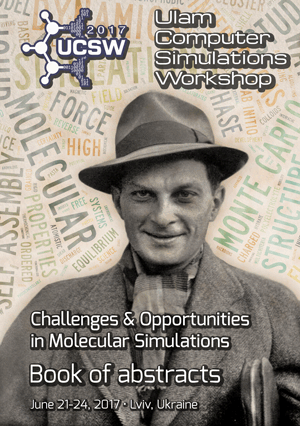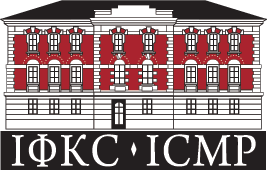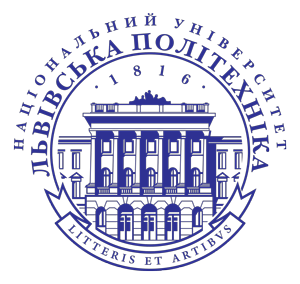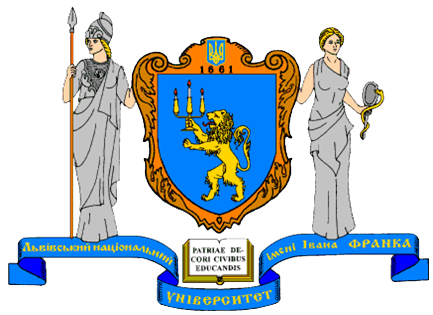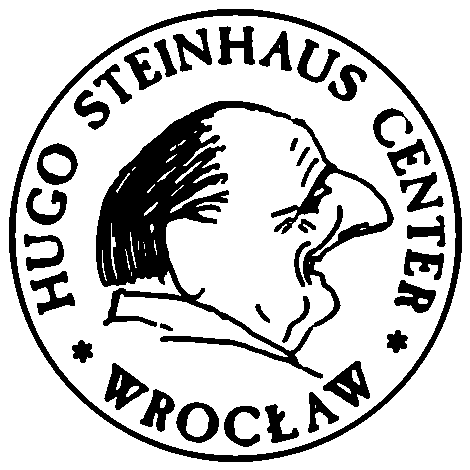Timetable
Wednesday
June 21st
9.00 - 18.00
Arrival, registration, City sightseeing
18.00 - 19.40
Polytechnic University
Conference hall in the main building of Lviv Polytechnic University where in 1932 Ulam has presented his PhD thesis.
Oppening
Lecture about Ulam
Invited lecture
Lecture about Ulam
Invited lecture
20.00-22.00
Panorama Bar in Dnister Hotel
Welcome mixer
Thursday
June 22nd
9.00 - 20.00
Franko University
Invited lectures, short contributions, poster session
20.00 - 22.00
Szkocka Restaurant
Informal dinner in Szkocka Restaurant where the original Scottish Cafe was located and the legendary Scottish Book prepared by Ulam was originated.
Friday
June 23rd
9.00- 19.00
Franko University
Invited lectures, short contributions
20.00 - 22.00
Italian Yard
Workshop banquet
Saturday
June 24th
9.00 - 18.00
Departure, City sightseeing
Detailed program
Wednesday, 21 June, 2017
- 14.00 - 18.00
- Registration
- 18.00 - 18.20
- Opening address
- 18.20 - 19.00
- M. ZARICHNYI (Lviv, Ukraine) Stanislaw Ulam: life, mathematics, and science
- 19.00 - 19.40
- D. FRENKEL (Cambridge, UK) Certainty from uncertainty and order from disorder: how the Monte Carlo method changed our understanding of entropy
- 20.00 – 22.00
- Social Mixer
Thursday, 22 June, 2017
- 9.00 - 9.40
- G. CICCOTTI (Rome, Italy) Hydrodynamics from dynamical non-equilibrium molecular dynamics
- 9.40 - 10.00
- R. Vuilleumier (Paris, France) Extracting random forces and Mori-Zwanzig kernels from molecular dynamics simulations
- 10.00 - 10.20
- N. Jakse (Grenoble, France) Is diffusion in liquid metals universal?
- 10.20 - 10.40
- A. Weron (Wrocław, Poland) Algorithms for testing of fractional dynamics: A practical guide for stochastic modelling
- 10.40 - 11.10
- Coffee Break
- 11.10 - 11.50
- A. SEITSONEN (Paris, France) Liquid of Life in silico: Electronic structure-based atomistic simulations of liquid water
- 11.50 - 12.10
- J.-F. Wax (Metz, France) Dynamic structure of liquid water
- 12.10 - 12.30
- E. Sanz (Madrid, Spain) What simulations can teach us about homogeneous ice nucleation
- 13.00 - 14.00
- Lunch
- 14.30 - 15.10
- E. SPOHR (Essen, Germany) Electrostatic driving forces in molecular simulations of stochastic proton discharge reactions on electrodes. Beyond a 1D-Poisson-Boltzmann view
- 15.10 - 15.50
- S. BONELLA (Lausanne, Switzerland) Molecular dynamics simulation of charged systems in external magnetic field
- 15.50 - 16.20
- Coffee Break
- 16.20 - 17.00
- D. KOFKE (Buffalo, USA) Mapped averaging methods for high-precision, high-efficiency calculation of properties by molecular simulation
- 17.00 - 17.20
- R. Davidchak (Leicester, UK) Langevin and gradient thermostats for rigid body dynamics
- 17.20 - 17.40
- A. Henrici(Winterthur, Switzerland) Fermi-Pasta-Ulam chains: simulation and theory
- 17.40 - 18.00
- A. Huerta(Xalapa, México) Computer simulations of low-dimensional materials
- 18.00 - 19.00
- Poster session
- 19.00 - 20.00
- Walking Tour
- 20.00 – 22.00
- Szkocka Dinner
Friday, 23 June, 2017
- 9.00 - 9.40
- G. KAHL (Vienna, Austria) Inverse patchy colloids: structure, dynamics, and self-assembly from Monte Carlo simulations
- 9.40 - 10.00
- S. Sokolowski (Lublin, Poland) Molecular Dynamics studies of hairy nanoparticles in confined systems
- 10.00 - 10.20
- A. Baumketner (Lviv, Ukraine) Monte Carlo study of cluster crystals stabilized by hydrophobic and electrostatic interactions
- 10.20 - 10.40
- S. Perepelytsa (Kyiv, Ukraine) Dynamics of counterions in the ion-hydrate shell of DNA double helix: A molecular dynamics study
- 10.40 - 11.10
- Coffee Break
- 11.10 - 11.50
- I. SIEPMANN (Minneapolis, USA) First principles Monte Carlo simulations of phase, sorption, and reaction equilibria
- 11.50 - 12.10
- I. Nezbeda (Ústí nad Labem, Czech Republic) Evaluation of the contact angle from molecular simulations
- 12.10 - 12.30
- S. Ravipati (London, UK) Contact angle of nanodroplets from molecular dynamics simulations
- 13.00 - 14.00
- Lunch
- 14.30 - 15.10
- N.QUIRKE (London, UK) Excess electrons in polyethylene: molecular dynamics and ab initio studies
- 15.10 - 15.50
- K. PROCHÁZKA (Prague, Czech Republic) Coarse-grained simulations of polymer and polyelectrolyte self-assembly
- 15.50 - 16.20
- Coffee Break
- 16.20 - 17.00
- J. GROSS (Stuttgart, Germany) Molecular simulations of phase equilibrium properties and force field development supported by analytic fluid theories
- 17.00 - 17.20
- M. Horsh (Kaiserslautern, Germany) Multicriteria optimization of molecular force field models
- 17.20 - 17.40
- T. Żórawik (Wrocław, Poland) Levy walks: theory and simulations
- 17.40 - 18.00
- B. Nowakowski (Warsaw, Poland) Monte Carlo simulation of stochastic effect in thermochemical system
- 18.00 - 18.20
- Closing remarks
- 18.20 - 20.00
- Walking Tour
- 20.00 - 22.00
- Workshop Dinner
Invited lectures
- Giovanni Ciccotti Istituto di Applicazioni del Calcolo "Mauro Picone" (IAC), CNR, Roma Universita’ di Roma “La Sapienza” School of Physics, University College of Dublin
-
Hydrodynamics from dynamical non-equilibrium molecular dynamicsOur starting point will be the relationship between hydrodynamics from the macroscopic continuum point of view and its atomistic interpretation in statistical mechanical terms. Then we extend stationary state (equilibrium and non-equilibrium) Molecular Dynamics to time dependent situations, including response and relaxation. We call the procedure Dynamical Non-Equilibrium Molecular Dynamics (D-NEMD), to distinguish it from standard NEMD, rigorously useful only to simulate stationary non-equilibrium states. It is, in essence, a generalization of linear response theory. The idea, formulated by Onsager in the thirties in metaphysical language, has received a solid foundation in the fifties by the work of Kubo (in the linear and nonlinear regimes). Adapted to MD simulations by G.Jacucci , I.R.Mac Donald and myself in the seventies, it has been baptized as the (nonlinear) Kubo-Onsager relation, connecting dynamical non-equilibrium averages or dynamical relaxations to initial distribution which can be sampled in MD by stationary processes. Finally we go back to hydrodynamics, to illustrate the method, by studying the hydrodynamic relaxation of an interface between two immiscible liquids.
- Daan Frenkel University of Cambridge, Cambridge
-
Certainty from uncertainty and order from disorder: how the Monte Carlo method changed our understanding of entropyUlam's ideas about 'random sampling' lie at the basis of all Markov-Chain Monte Carlo methods from Metropolis onwards. I will describe part of this story (including some very recent developments) and illustrate the power of the method by discussing what we have learned about the entropy of crystals and granular materials.
- Joachim Gross University of Stuttgart, Stuttgart
-
Molecular simulations of phase equilibrium properties and force field development supported by analytic fluid theoriesThe development of fluid theories is long since facilitated by molecular simulations. This contribution emphasizes that molecular simulations can in turn also be facilitated by analytic fluid theories. It is shown how an analytic equation of state can be used to significantly enhance the convergence characteristics of the multidimensional force field optimization. The procedure is iterative, due to imperfect approximations of the model, but convergence is swift and the final result is not biased by the analytic model. We show results for the development of a transferable force field for pure substances and for mixtures. It is further emphasized how the analytic model can be used to estimate properties that are otherwise unknown a priori. Monte Carlo simulations in the grand canonical ensemble for example require as input values of the chemical potential for a series of temperatures approximately corresponding to coexistence conditions.
- Gerhard Kahl Vienna University of Technology-TU Vienna, Vienna
-
Inverse patchy colloids: structure, dynamics, and self-assembly from Monte Carlo simulationsAnisotropy – be it in shape or in the interactions – has turned out to be an essential feature of colloidal particles that triggers their self-assembly strategies into mesoscopic target structures with desired properties. A relatively novel class of colloids that feature anisotropy in their interactions are colloidal particles whose surface is decorated by a heterogeneous charge distribution. As the particles are charged themselves, the interplay of attraction and repulsion between oppositely and likely charged surface regions guarantees that these colloids are able to form highly directional and, at the same time, strongly selective bonds with other particles. This particular bonding mechanism is the reason why such particles are ideally suited to self-assemble into highly stable ordered structures which are otherwise inaccessible to conventional colloidal particles with surface decoration (commonly termed patchy particles). The fact that, in addition, the differently charged regions are susceptible to external stimuli (such as electric fields) make such particles ideal building entities in targeted bottom-up assembly processes. Quite a few theoretical models for such particles have been put forward in literature; this contribution will focus on Monte Carlo simulation based investigations on the physics of charged particles, decorated on their polar regions by oppositely charged patches. These colloids show an unexpected rich variety of self-assembly scenarios, which can be triggered by confinement and/or external electric fields. One of the preferred ordered structures of these colloids are lamellar phases: they can emerge as hybrid crystal-liquid structures where transport of particles takes place through an otherwise stable layered structure.
- David Kofke The State University of New York, Buffalo
-
Mapped averaging methods for high-precision, high-efficiency calculation of properties by molecular simulationWe present a general framework for reformulation of the ensemble averages commonly encountered in statistical mechanics. This “mapped-averaging” scheme allows approximate theoretical results that have been derived from statistical mechanics to be reintroduced into the underlying formalism, yielding new ensemble averages that represent exactly the error in the theory. The result represents a distinct alternative to perturbation theory for methodically employing tractable systems as a starting point for describing complex systems. Calculation of the reformulated averages by molecular simulation can proceed without contamination by noise produced by behavior that has already been captured by the approximate theory. Consequently, accurate and precise values of properties can be obtained while using less computational effort, in favorable cases, many orders of magnitude less. The framework opens many avenues for further development, both as a means to improve simulation methodology and as a new basis to develop theories for thermophysical properties.
- Karel Prochazka Charles University, Prague
-
Coarse-grained simulations of polymer and polyelectrolyte self-assemblyThe behavior of high-molar-mass compounds and the most important differences between systems of small molecules and long polymer chains will be briefly outlined in the short introduction. The first part of the lecture will be devoted to the explanation of principles of dissipative particle dynamics (DPD) simulations and to their applications for studies of polymer systems. DPD is a coarse-grained molecular dynamics, which employs three types of forces acting between the DPD beads: (a) conservative force (derived from interaction potentials), (b) dissipative force (emulating friction) and (c) random force (emulating thermal motion and random collisions). A considerable part of the presentation will focus on еhe implementation of electrostatic forces into DPD machinery and on the calibration of repulsion and electrostatic forces with respect to each other. In the second (main) part of the lecture, we will present several examples of DPD studies of the electrostatic self-assembly of polyelectrolytes and show how the coarse-grained simulations help to improve the understanding and interpretation of experimental data. We will discuss both the behavior of stoichiometric and non-stoichiometric polyelectrolyte mixtures.
- Nick Quirke Imperial College, London
-
Excess electrons in polyethylene: molecular dynamics and ab initio studiesThe behaviour of an excess electron in ordered and amorphous polymer materials is both a practical problem of immense commercial importance and a fundamental problem involving electron localisation in disordered materials. Breakdown of high tension cables used to transmit power over long distances has been linked to electron trapping while, although it has been known for 50 years , that disorder localises electrons , it has not been obvious how the localisation is linked to local structure and chemistry in real materials. We have employed classical molecular dynamics and various ab initio methods to study this problem in polyethylene (1-7). We will discuss computer simulations of an excess electron in various structural motifs of polyethylene at room temperature, including lamellar and interfacial regions between amorphous and lamellae, as well as nanometre-sized voids. Electronic properties such as density of states (\DoS), mobility edges, and mobilities are computed on the different phases using a block Lanczos algorithm. Our results suggest that the electronic density of states for a heterogeneous material can be approximated by summing the single phase density of states weighted by their corresponding volume fractions. Additionally, a quantitative connection between the localized states of the excess electron and the local atomic structure is presented. For more complicated chemistries we would like to use all electron DFT as it avoids the necessity of creating pseudopotentials for systems with many different interactions. It is not obvious how to calculate the excess electron properties within DFT. We have tested all electron DFT against one electron methods for methane and for polyethylene including polyethylene/vacuum interfaces. Finally we will show results for various interfacial systems that would be fund in polymer nanocomposites. Reference will be made to the use of the one electron DoS in Monte Carlo methods to predict conductivity of bulk materials.
- Ari Seitsonen École Normale Supérieure de Paris, Paris
-
Liquid of Life in silico: Electronic structure-based atomistic simulations of liquid waterWater, due to its involvement in various of our every day life events, practical applications and scientific research disciplines, serves as an important test case for atomistic computer simulations. As parametrised or polarisable force fields yield overall reasonably good an accuracy in comparison with experimental findings, the methods where the electronic structure is explicitly solved at every time step in order to obtain the total energy of the system and/or forces acting on the ionic nuclei need to demonstrate a superior accuracy in order to justify the vast additional computing time required. Progress has been achieved in recent years, but improvement is still necessary to achieve a satisfying level of quality in the results, and that we can rely on the predictive capabilities of the simulations.
In this Presentation we review the recent literature on the simulation of liquid water using the electronic structure-based methods. We concentrate on the results obtained with the Density Functional Theory-based Molecular Dynamics (DFTbMD) approach, but we shortly demonstrate related approaches as well. We enlist various properties, from the geometric structure, to dynamical, vibrational and electronic quantities. In particular we demonstrate the recent evaluation of the melting temperature of water using such simulations. Within the DFTbMD scheme we discuss the influence of the choice of the approximation of the exchange-correlation term to the results obtained. We also mention the recent progress in describing the nuclear quantum effects in liquid water, yielding ever-improving degree of reality in the computer simulations. - Ilja Siepmann University of Minnesota, Minneapolis
-
First principles Monte Carlo simulations of phase, sorption, and reaction equilibriaThis talk will highlight recent developments enabling first principles Monte Carlo (FPMC) simulations for which energies are calculated on the fly using Kohn-Sham density functional theory. Applications of FPMC to the prediction of vapor-liquid equilibria for water, adsorption isotherms for gas molecules in metal-organic frameworks, and reaction equilibria in compressed vapors and in porous materials will be discussed.
- Eckhard Spohr University of Duisburg-Essen, Essen
-
Electrostatic driving forces in molecular simulations of stochastic proton discharge reactions on electrodes. Beyond a 1D-Poisson-Boltzmann viewApproximately 20,000 proton discharge events from aqueous NaCl solutions to charged electrodes, obtained from classical Molecular Dynamics trajectories with an empirical valence bond reactive force field for varying surface charge densities of the electrode and varying electrolyte solution compositions (sets with different numbers of cations and anions) are analysed. Individual trajectories are started randomly from equilibrated snapshots of a non-reactive system. We calculate static and dynamic average electric fields acting on the proton transfer complex in directions perpendicular and parallel to the electrode surface. The time evolution of electric fields and of hydrogen bonding just before the discharge events provide insight into the discharge mechanism. Since the description of hydrogen bonding in force field models of water and aqueous solutions is an electrostatic one, the relative importance of global ('electrochemical') and local ('hydrogen bonding') electric fields on the reaction mechanism will be assessed in a stochastic manner.
- Mykhailo Zarichnyy Ivan Franko National University of Lviv, Lviv
-
Stanisław Ulam: life, mathematics, and scienceThe talk is devoted to a (mathematical and scientific) biography of Stanisław Ulam. A special attention will be paid to Ulam's mathematical achievements.
Short contributions already accepted
- Andriy Baumketner Institute for Condensed Matter Physics, Lviv
-
Monte Carlo study of cluster crystals stabilized by hydrophobic and electrostatic interactionsThe term “cluster crystal” refers to crystalline materials in which each site is occupied by multiple entities of the same sort, atoms, colloids or polymers that, collectively, are known as clusters. There are two types of systems that are able to make cluster crystals: a) those that interact via potentials that are bound at the origin and thus allow inter-penetration of constituent particles and b) those that are represented by particles of finite size and, possibly, hard cores. Systems of the first class, polymers, dendrimers and other soft materials, have received much attention over the last several years. In this presentation we will focus on systems of the second class, such as colloids.
First we will establish conditions required for the cluster crystal assembly using a simple model potential and Monte Carlo simulations. Next we will show how potentials with the required properties can be generated by combining hydrophobic attraction at short distances and electrostatic repulsion at long distances. For that purpose, colloidal particles that consist of a hard-sphere core and a repulsive wall will be introduced as a model of hydrophobic interaction. Charge will be added to the colloids to induce the long-range repulsion. Effective interactions between colloids in explicit solvent will be computed as potentials of mean force in umbrella sampling simulations. For select models molecular dynamics simulations will establish the stability of the cluster crystal conformations at room temperature. Finally we will comment on how finite-size systems making cluster crystals can be realized in practice. - Sara Bonella CECAM Ecole Polytechnique Fédérale de Lausanne, Lausanne
-
Molecular dynamics simulation of charged systems in external magnetic fieldThe current statistical mechanics description of charged systems subject to external magnetic field, dating back to the work of Kubo in the 1950s and commonly upheld today, states, in particular, that the parity properties of time-correlation functions cannot be established because the direct coupling of momenta and coordinates in the Hamiltonian hinders standard time reversal symmetry for these systems. In fact, this and other related results, such as the Onsager relations, refer to relationships between systems in two oppositely oriented magnetic fields, an unsatisfactory situation given that experiments and simulations usually occur in a single field.
In this Presentation, two new generalized time reversal symmetries are introduced. These symmetries enable to determine parity of time correlation functions for a single field and, more in general, make it possible to recast several aspects of the theory for these systems on the same formal footings as for those with Hamiltonians of standard form. They also allow predicting zero cross correlation between specific pairs of observables and thus establish analytically the behavior of some elements of the diffusion and conductivity tensors difficult to access experimentally or numerically.
Employing a recently developed algorithm based on the Liovillian formalism, it will be shown that these theoretical findings are indeed verified in molecular dynamics simulations of superionic conductors. Furthermore, it will be shown that, using these new formal and algorithmic tools, the on-set of the ionic Hall effect and ionic magnetoresistance in AgI and CaF2 can be characterised via simulation, with results in very good agreement with experiments, when available. - Ruslan Davidchack University of Leicester, Leicester
-
Langevin and gradient thermostats for rigid body dynamicsWe introduce new Langevin and gradient (Brownian) thermostats for rigid body dynamics, which can be used in molecular dynamics simulations of systems with rigid body components. Rotations are represented by unit quaternions and the proposed numerical integrators for these thermostats automatically preserve the unit length of quaternions. In addition, the Langevin integrators also ensure that the conjugate quaternion momenta remain tangent to the quaternion coordinates. The Langevin integrators are quasi-symplectic and of weak order two. The integrator for the gradient thermostat is of weak order one. We numerically compare the discretization errors of the Langevin integrators, as well as the efficiency of the gradient integrator compared to the Langevin ones when used in the simulation of rigid TIP4P water model with smoothly truncated electrostatic interactions. Finally, we present a new rigid body Langevin thermostat and numerical integrator for the simulation of systems with hydrodynamic interactions, which can be used for modelling the dynamics of colloids, DNA, proteins and other macromolecules in solutions. The performance of this thermostat and integrator is demonstrated in numerical experiments of several model systems.
- Andreas Henrici ZHAW School of Engineering, Winterthur
-
Fermi-Pasta-Ulam chains: simulation and theoryIn the early 1950s, Enrico Fermi, John Pasta, and Stanislaw Ulam (FPU) numerically simulated a one-dimensional chain of mass points connected by weakly nonlinear forces (FPU chains); it was one of the first computer simulations for purely scientific purposes. The intention was to test some simple assumptions of equilibrium statistical mechanics such as ergodicity or the equipartition of energy; Fermi predicted that the energy of the chain would asymptotically be distributed equally among the different harmonic modes. However, the experiments showed that this was not the case. The assumed thermalization did not occur, the energy seemed to oscillate between the first few harmonic modes in a quasi-periodic way, a phenomenon which was henceforth known as the “FPU paradoox”.
Since then, the quest for an explanation of this unexpected stability has been going on, and various possible explanations have been proposed; most of these explanations are either soliton-based or use perturbative approaches. Here, we discuss one of the possible perturbative explanations, namely the Kolmogorov-Arnol'd-Moser (KAM) theorem and related results, together with their applicability to FPU chains.
Precisely, we formulate a model of FPU chains, give an overview of the KAM theorem and related results of perturbation theory, and show how these abstract results can be applied to FPU chains; we also make some remarks on some special case of FPU chains, the so-called Toda lattice, which has especially strong integrability properties.
Besides its practical signifance as a model for various phenomena in areas such as solid state physics, the research on FPU chains is one of the first examples of research in mathematical and theoretical physics which is driven by experiments of computer simulations and not by laboratory experiments; Fermi, Pasta, and Ulam thus initiated the use of computer not just as tools for doing computations, but as electronic laboratories. - Martin Thomas Horsch University of Kaiserslautern, Kaiserslautern
-
Multicriteria optimization of molecular force field modelsTo reach the precision required by engineering applications, molecular models need to be adjusted to a variety of thermodynamic properties. This implies the presence of multiple conflicting objectives. In the present work, the two-centre Lennard-Jones plus point quadrupole (2CLJQ) model class is considered, and the multicriteria optimization problem is addressed by constructing the Pareto front, i.e., the set of rational compromises, from which models tailored to special needs can subsequently be chosen consciously by individual users or automatically, e.g., by thermodynamic property databases and simulation software.
Ten real quadrupolar fluids are considered here by multicriteria optimization: Nitrogen, oxygen, fluorine, chlorine, bromine, ethane, ethylene, acetylene, perfluoroethylene, and perchloroethylene. Three optimization criteria are defined by the normalized root mean square deviation for the saturated liquid density, the saturated vapour pressure, and the vapour-liquid surface tension. A recently developed efficient long-range correction scheme is used to determine the surface tension by molecular dynamics simulation with a high precision. An approach based on self-organizing patch plots is introduced for visualizing the Pareto front. The Pareto knee region is investigated, and model parameterizations are identified which constitute an overall compromise between interfacial and bulk properties.
From previous work, 2CLJQ models are available for 29 low-molecular fluids. These models are validated against the vapour-liquid surface tension, to which they were not adjusted. It is found that on average, the vapour-liquid surface tension is overestimated by about 20%, and that a significant improvement can be achieved by multicriteria optimization. - Adrián Huerta Universidad Veracruzana, Xalapa
-
Computer simulations of low-dimensional materialsThe caging mechanism, introduced by Huerta, Henderson, Trokhymchuk in 2006 to describe the freezing of two dimensional hard disks, is applied here to contrast the frustration of freezing of a binary mixture of hard disks and overlapped hard dumbbells, both by using Monte Carlo simulations. In both cases the caging mechanism is frustrated but, meanwhile the binary mixture shows an extension of the fluid-like branch avoiding the solidification, the hard dumbbells shows a KTHNY-like transition. Extensions to study other low-dimensional systems are discussed.
- Noel Jakse Universuité Grenoble Alpes, Grenoble
-
Is diffusion in liquid metals universal?Understanding how dynamic properties depend on the structure and thermodynamics in liquids is a long-standing open problem in condensed matter physics. Our current knowledge is based on two different contributions developed for model fluids in which universal scaling relationships between the excess entropy of the fluid and its reduced diffusion coefficient is considered. Difference holds in the way to obtain reduction parameters, using either macroscopic arguments as proposed by Rosenfeld or microscopic ones as in the Dzugutov scheme. However their applications to “real” liquids still remains elusive due to the ability of model reference fluids to describe more complex interactions that may occur in the real systems. The purpose of this contribution is use ab initio molecular dynamics simulations to calculate both structural and dynamic properties at different temperatures for a wide series of liquid metals including Al, Au, Cu, Li, Ni, Ta, Ti, Zn as well as liquid Si and B, as well as Aluminum-based liquid alloys From this analysis, we demonstrate that the Dzugutov scheme remains successful only if a self-consistent method to determine the packing fraction of the hard sphere reference fluid as well as an appropriate approach to express the excess entropy are used. We compare our results with original Rosenfeld’s scaling law as well as with its generalized version proposed very recently for pure metals.
- Ivo Nezbeda Czech Academy of Sciences & J. E. Purkinje University, Prague
-
Evaluation of the contact angle from molecular simulationsAn alternative method for determination of the contact angle of droplets at a solid underlay from molecular simulations is proposed. The method is based on a recently developed general method of identification the surface molecules of a molecular system with the interface of an arbitrary shape and on a subsequent parametrization of the surface of the droplet by a smooth function. The method has been verified first by considering two artificial systems with the exactly known contact angles and then by comparison with literature data for two realistic systems.
- Sergiy Perepelytsya Bogolyubov Institute for Theoretical Physics, NAS of Ukraine, Kyiv
-
Dynamics of counterions in the ion-hydrate shell of DNA double helix: A molecular dynamics studyStarting with the early works by Rosalind Franklin, James Watson and Francis Crik, water molecules and metal counterions revealed the essential role in organization of the structure of DNA macromolecule. Now it is well known that water molecules are indispensable for the formation of stacked base pairs in the double helix, while the counterions neutralize the negatively charged phosphate groups of the macromolecule backbone, reducing the electrostatic repulsion between different strands of the macromolecule. Due to the regular structure of the double helix the counterions tethered to DNA may form an ordered system of charges around macromolecule. Considering such system as the lattice of ionic type it has been shown that the dynamics of DNA is characterized by ion-phosphate vibrations that are prominent in the low-frequency spectra range (<200 cm-1). To study the dynamics of ordered counterions around the double helix the molecular dynamics simulation of DNA fragment d(CGCGAATTCGCG) in water solution with different ions (Na+, K+, Cs+ and Mg2+) have been performed. The results of preliminary study have been also used. The obtained results show that the Na+ counterions interact with the phosphate groups directly from outside of the double helix and via water molecules at the top edge of DNA minor groove. K+ ions interact with the phosphate groups (directly and via water molecules) and with the atoms of nucleic bases from the minor groove of the double helix. The cesium ions penetrate deeply inside the minor groove and interact directly with the atoms of nucleic bases. Cs+ counterions form a structured system of charges in the DNA minor groove that may be considered as a specific case of ionic lattice. The magnesium ions interact with the atoms of DNA only via water molecules of the hydration shell. The considered ions in the major groove of the double helix do not have a defined interaction site.
- Srikanth Ravipati Imperial College London, London
-
Contact angle of nanodroplets from molecular dynamics simulationsWith the computational tools available today it is straightforward to simulate a sessile drop on a substrate, but analysis of the droplet to estimate the contact angle is still ambiguous. Most commonly employed methods either use diverse choices of parameters in the analysis, different interface profile fitting functions or require a large number of particles. To address this problem, we propose a methodology that does not presume any shape of the interface and consider an appropriate coarse-grained density field from discrete particles. We calculate the contact angle values of sessile drops using the proposed method for three different systems: (i) Lennard Jones (LJ) drop on LJ 9—3 surface, (ii) SPC/E water drop on LJ 9—3 surface and (iii) SPC/E water drop on graphite surface. We compare the sessile drop contact angles with Young contact angle values for the first two systems and observe a very good agreement.
- Eduardo Sanz Universidad Complutense de Madrid, Madrid
-
What simulations can teach us about homogeneous ice nucleationIn the last 5 years we have been using computer simulations with the aim of shedding light in the process of ice nucleation. Such process is the first step of water freezing, arguably the liquid-to-solid transition with the greatest relevance on Earth. In particular, the extent of freezing in atmospheric clouds has a great impact on the Earth's albedo and, therefore, on climate change. Simulations is a particularly suitable tool to study ice nucleation because it enables access to the time and length scales relevant to this process, ns and nm, complementing the information obtained in experiments where such small scales can not be probed.
Using simple models for simulating water we have been able to reach a nearly quantitative agreement with experimental ice nucleation rates. We have used the information drawn in our simulations to gain a better understanding of the ice nucleation process in terms of molecular mechanism and thermodynamic parameters affecting the nucleation rate. With this information we propose a tentative explanation for the decelerating effect of pressure on ice nucleation as well as for current discrepancies in measurements of the nucleation rate between different experimental groups. - Stefan Sokolowski MCS University, Lublin
-
Molecular Dynamics studies of hairy nanoparticles in confined systemsMolecular Dynamics simulations are used to study the structure of hairy nanoparticles at a hard wall. Two models of hairy particles are considered. In the first case the chains are tethered at fixed points of the core molecule, while in the second case they can slide over the core surface. In both models the chains have been built of tangentially jointed spherical segments. We have determined local densities of core molecules and of segments of chains, radial distribution function for pairs molecules located in some selected slabs parallel to the wall, the end-to-end distances for tethered segments. Moreover, we have employed the concept of mass dipole to characterize how the distribution of the segments of chains around the cores changes with the distance to the surface.
- Rodolphe Vuilleumier Ecole normale supérieure and UPMC, Paris
-
Extracting random forces and Mori-Zwanzig kernels from molecular dynamics simulationsThe influence of the environment on the dynamics of a subsystems has two components: a random force and a friction force. This friction, which describes the feedback of the envrionment on the subsystem dynamics, is in general retardated and the environment keeps a memory of the past dynamics of the subsystem. This was formalized by Mori and Zwanzig, who introduced for this purpose projection operators, which single-out the degrees of freedom of interest. In this formalism, the dynamics of the subsystem is described by a generalized Langevin equation. The memory kernel for this evolution, that describe the retardation of the friction force, is the correlation function of the random force. This correlation function however is unusual as the force is not propagated along the normal dynamics but along an orthogonal dynamics. Here we will describe how, using an explicit representation of the orthogonal dynamics, the Mori-Zwanzig memory kernel can be computed from standard molecular dynamics simulations.
We will then apply this algorithm to the computation of the Mori-Zwanzig memory kernel of a Lennard-Jones particle immersed in a fluid of identitcal Lennard-Jones particles. We will show that this Mori-Zwanzig memory kernel decays algebraically. We will relate this algebraic decay to the hydrodynamic response of the bath and identify it with the Basset-Boussinesq force. Finally, an added mass to the particle mass will be extracted from the Mori-Zwanzig memory kernel. At odds with incompressible hydrodynamics predictions, this mass term is negative in the present case. - Jean-François Wax University of Lorraine, Metz
-
Dynamic structure of liquid waterIn this work, we study the dynamic structure of liquid water by classical molecular dynamics simulations. We compare the collective excitations spectra predicted by two rigid models of interactions, non-polarizable SPC/E and polarizable BK3 models. After having discussed the influence of the polarizability of the molecule on this property, we investigate its density and temperature dependence.
- Aleksander Weron Wrocław University of Science and Technology, Wrocław
-
Algorithms for testing of fractional dynamics: A practical guide for stochastic modellingIn this talk we present a systematic methodology which demonstrates how to identify the origins of fractional dynamics. We consider three mechanisms which lead to it, namely fractional Brownian motion, fractional Levy stable motion and an autoregressive fractionally integrated moving average (ARFIMA) process. The methodology is based on statistical tools for identification and validation of the fractional dynamics, in particular on an ARFIMA parameter estimator, an ergodicity test, a self-similarity index estimator based on sample p-variation and a memory parameter estimator based on sample mean-squared displacement. Finally, we illustrate the methodology on biological SPT data and show that ARFIMA can be considered as a universal model for fractional dynamics. Thus, we provide a practical guide for experimentalists on how to efficiently use ARFIMA modelling for a large class of anomalous diffusion data.
- Tomasz Żórawik Wrocław University of Science and Technology, Wrocław
-
Lévy walks: theory and simulationsLévy walks are useful models of anomalous diffusion and have found a number of applications in physics and biology. We present some newest key results regarding their probability distributions and aging property in ballistic regime. In particular we show that despite a complicated memory structure and the appearance of α-stable processes in the definition of 3D isotropic Lévy walks their probability density functions are given by elementary functions. In 2D the result for PDF is more complicated and it requires a fractional derivative and hypergeometric functions.
We also discuss a simulation algorithm for these processes. It turns out that there is a perfect agreement between statistics obtained via Monte Carlo simulations and our theoretical findings.

